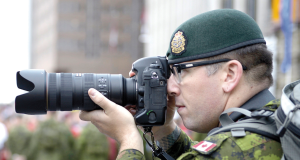Image Techs focus on documenting history
By Lookout on May 04, 2015 with Comments 1

Cpl Philippe Archambault an Imagery Technician from the Directorate of Army Public Affairs, covering the 2013 Canadian Army Run in downtown Ottawa, ON.
Imagery Technicians with the Canadian Armed Forces are the trade behind the lens.
They are entrusted to capture, in photos or videos, the individual moments and pervasive spirit of the Canadian military and its members.
A member of the trade today is both an historian and a photojournalist.
The technician is tasked with documenting the actions of the CAF for the Government of Canada and the world, and to bear witness to the amazing stories of Canadian soldiers, sailors, airmen and airwomen.
Imagery technicians work alongside other CAF members in the Army, Navy and Air Force to document important events in the life and times of the Forces.
They may work at any base in Canada, on ships at sea and overseas as part of United Nations, NATO and other missions.
The images and videos they capture are used for training, flyers, posters, public affairs and higher strategic requirements.
An imagery technician might tag along with infantry one day, military police another day and medics the next.
Always, however, the imagery technician’s goal is to tell the soldiers’ stories of struggle, sacrifice and success with the best possible images.
Sgt Dan Shouinard, Imagery Supervisor and acting Operations Warrant, Directorate Army Public Affairs, has photographed still and video images of a wide range of Army experiences since he joined the regular force in 2001 as an imagery technician.
“We are witnessing and recording history,” said Sgt Shouinard, “which is why many imagery technicians say they have the best job in the CAF.”
Another job benefit, according to Sgt Shouinard, is that imagery technicians get to see each and every military job and observe the dedicated work of other CAF members firsthand.
Sgt Shouinard started out as a reservist in 1995 before completing college programs in graphic design and interactive multimedia.
Before taking up his current supervisory role at Army Headquarters in Ottawa in 2013, he had served two deployments as a public affairs imagery technician in Afghanistan, in 2005 and 2011.
His portfolio includes more mundane photos of the loading of a CC-177 Globemaster transport plane for the loadmaster’s record to exhilarating pictures taken from the open doorway of a Chinook helicopter during a familiarization flight over Kandahar Province.
While in Nova Scotia, his skills supported the creation of search-and-rescue training videos, intelligence work and the coaching of Airborne Electronic Systems Operators in imaging techniques.
History books are packed with military images that have stayed with Sgt Shouinard, such as famous still photos from the First and Second World Wars and the Korean War as well as examples of live-action newsreels showing Canadian troops landing on the beaches of Normandy in 1944.
When Sgt Shouinard reflects back on the evolution of the military imagery technician trade, from Brownie box cameras to today`s digital wonders, he notes, “First World War photographers were legendary – not only for their techniques, but also for the emotion in their photographs, which reflected both the content of the image and the event captured.”
Today’s imagery technicians aim to live up to those standards.
Following basic training, recruits attend Canadian Forces School of Aerospace Technology and Engineering in Borden, Ont., for a four-month training, where recruits learn how to use a video and still camera, how to set up lighting equipment and much more.
Specialty training may occur through course work or on-the-job training in photojournalism, advanced video production, multi-media production, underwater photography, as well as high-speed photography and video techniques.
Imagery technicians go out either individually or in small teams or may embed with a unit or section out in the field, a helicopter squadron or a ship to cover the mission or exercise.
“It’s a position that requires physical fitness and a positive attitude – someone who is outgoing and ready to do the things that a lot of people aren’t willing to suffer through,” said Sgt Shouinard.
“They are not infantry soldiers, but they do pre-deployment training, go out on operations and spend a lot of time away from home.”
Every day, imagery technicians record the true story of today’s CAF through photography and video.
From time to time, they may reflect back on the history of their trade, from the front lines of the Great War to Afghanistan and onward, while always keeping the focus on the future.
Or as Sgt Shouinard best captures it: “Imagery technicians are the living historians of the CAF.”
Army Public Affairs
Filed Under: Top Stories
About the Author:






An interesting lens to view the world, but some of those assignments my lens would be shaking like a leaf.